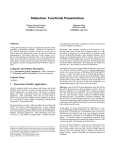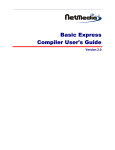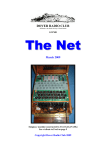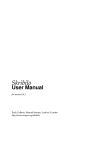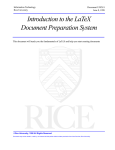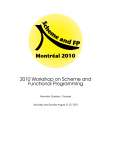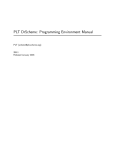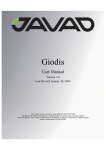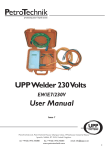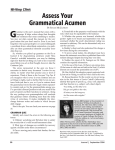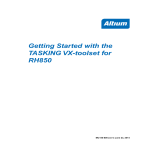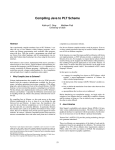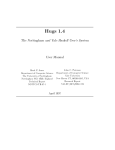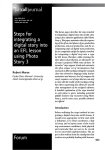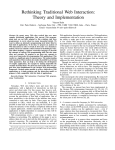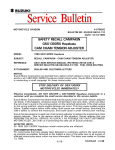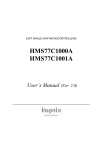Download Slideshow: Functional Presentations
Transcript
Under consideration for publication in J. Functional Programming 1 Slideshow: Functional Presentations ROBERT BRUCE FINDLER University of Chicago (e-mail: [email protected]) MATTHEW FLATT University of Utah (e-mail: [email protected]) Abstract Among slide-presentation systems, the dominant application offers essentially no abstraction capability. Slideshow, an extension of PLT Scheme, represents our effort over the last several years to build an abstraction-friendly slide system. We show how functional programming is well suited to the task of slide creation, we report on the programming abstractions that we have developed for slides, and we describe our solutions to practical problems in rendering slides. We also describe experimental extensions to DrScheme that support a mixture of programmatic and WYSIWYG slide creation. 1 Abstraction-Friendly Applications Strand a computer scientist at an airport, and the poor soul would probably survive for days with only a network-connected computer and five applications: an e-mail client, a web browser, a general-purpose text editor, a typesetting system, and a slide-presentation application. More specifically, while most any mail client or browser would satisfy the stranded scientist, probably only Emacs or vi would do for editing, LATEX for typesetting, and Microsoft PowerPointTM for preparing slides. The typical business traveler would more likely insist on Microsoft WordTM for both text editing and typesetting. Computer scientists may prefer Emacs and LATEX because text editing has little to do with typesetting, and these different tasks are best handled by different, specialized applications. More importantly, tools such as Emacs, vi, and LATEX are programmable. Through the power of programming abstractions, a skilled user of these tools becomes even more efficient and effective. Shockingly, many computer scientists give up the power of abstraction when faced with the task of preparing slides for a talk. PowerPoint is famously easy to learn and use, it produces results that are aesthetically pleasing to most audience members, and it enables users to produce generic slides in minutes. Like most GUI-/WYSIWYG-oriented applications, however, PowerPoint does not lend itself easily to extension and abstraction. PowerPoint provides certain pre-defined abstractions—the background, the default font and color, etc.—but no ability to create new abstractions. Among those who refuse to work without abstraction, many retreat to a web browser (because HTML is easy to generate programmatically) or the various extension of TEX 2 R. B. Findler and M. Flatt (plus a DVI/PostScript/PDF viewer). Usually, the results are not as aesthetically pleasing as PowerPoint slides, and not as finely tuned to the problems of projecting images onto a screen. Moreover, novice users of TEX-based systems tend to produce slides with far too many words and far too few pictures, due to the text bias of their tool. Meanwhile, as a programming language, TEX leaves much to be desired. Slideshow, a part of the PLT Scheme application suite (PLT, n.d.), fills the gap left by abstraction-poor slide presentation systems. First and foremost, Slideshow is an embedded DSL for picture generation, but it also provides direct support for step-wise animation, bullet-style text, slide navigation, image scaling (to fit different display and projector types), cross-platform consistency (Windows, Mac OS, and Unix/X), and PostScript output (for ease of distribution). Functional programming naturally supports the definition of picture combinators, and it enables slide creators to create new abstractions that meet their specific needs. Even better, the Slideshow programming language supports a design recipe to help slide creators build and maintain animation sequences. Our design recipe guides the programmer from a storyboard sketch to an organized implementation, and it also suggests how changes in the sketch translate into changes in the implementation. Even with the best of programming languages, some slide sequences can benefit from a dose of WYSIWYG construction. WYSIWYG tools should be part of the slide language’s programming environment—analogous to GUI builders for desktop applications. We have implemented extensions of the DrScheme programming environment that support interactive slide construction in combination with language-based abstraction. Section 2 is a tour of Slideshow’s most useful constructs. Section 3 presents the Slideshow design recipe for picture sequences. Section 4 explains Slideshow’s core implementation. Section 5 briefly addresses practical issues for rendering slides on different media and operating systems. Section 6 describes our prototype extension of DrScheme. 2 A Tour of Slideshow A pict is the basic building block for pictures in Slideshow. Roughly, a pict consists of a bounding box and a procedure for drawing relative to the box. Ultimately, a slide is represented as a single pict to be drawn on the screen. This section demonstrates how to use Slideshow primitives to generate slides like the following, which might appear in a presentation about how fish gain weight when they eat other fish. Food Chain Yikes! 7 lbs 10 lbs Current total weight: 17 lbs After big fish eats little one: 17 lbs Slideshow: Functional Presentations 3 2.1 Pict Generators Slideshow provides several functions for creating picts of simple shapes. For example, the filled-rectangle function takes a height and a width and produces a pict: (filled-rectangle 20 10) Similarly, the text function takes a string, a font class, and a font size, and it produces a pict for the text. (text "10 lbs" ’(bold . swiss) 9) 10 lbs The standard-fish function takes a height, width, direction symbol, color string, eyecolor string, and boolean to indicate whether the fish’s mouth is open: (standard-fish 30 20 ’left "blue" "black" #t) The standard-fish function’s many arguments make it flexible. If we need multiple fish but do not need all of this flexibility, we can define our own fish function that accepts only the color and whether the fish’s mouth is open: ;; fish : str[color] bool -> pict (define (fish color open?) (standard-fish 30 20 ’left color "black" open?)) (define big-fish (fish "blue" #f)) (define big-aaah-fish (fish "blue" #t)) 2.2 Adjusting Picts If we need fish of different sizes after all, instead of adding arguments to fish, we can simply use Slideshow’s scale function: (define little-fish (scale (fish "orange" #f) 0.7)) We certainly want to place our fish into an aquarium, which we can draw as a light-blue rectangle behind the fish. The rectangle function does not accept a color argument; instead, it generates a rectangle that uses the default color, and the colorize function lets us adjust the default color for a pict. Thus, we can create a light-blue rectangle as follows: (colorize (filled-rectangle 20 10) "sky blue") 2.3 Combining Picts To create a pict with two fish, we can use ht-append: (ht-append 10 little-fish big-aaah-fish) 4 R. B. Findler and M. Flatt The first argument to ht-append is an amount of space to put between the picts. It is optional, and it defaults to 0. The ht part of the name ht-append indicates that the picts are horizontally stacked and top-aligned. Analogously, the hb-append function bottomaligns picts. If, we want to center-align picts, we can use hc-append: (define two-fish (hc-append 10 little-fish big-aaah-fish)) Now we are ready to place the fish into an aquarium. Our old aquarium, (colorize (filled-rectangle 20 10) "sky blue") is not large enough to hold the two fish. We could choose a fixed size for the aquarium, but if we later change the size constants in the fish function, then the aquarium might not be the right size. A better strategy is to create a function aq that takes a pict and makes an aquarium for the pict: ;; aq : pict -> pict (define (aq p) (colorize (filled-rectangle (pict-width p) (pict-height p)) "sky blue")) (aq two-fish) The pict-width and pict-height functions take a pict and produce its width and height, respectively. This aquarium is large enough to hold the fish, but it’s tight. We can give the fish more room by adding space around two-fish with Slideshow’s inset function, and then generate an aquarium pict. Finally, we put the fish and aquarium together using Slideshow’s cc-superimpose function: ;; in-aq : pict -> pict (define (in-aq p) (cc-superimpose (aq (inset p 10)) p)) (in-aq two-fish) The leftmost argument is placed bottommost in the stack, so the fish end up on top of the aquarium rectangle. The cc part of the name cc-superimpose indicates that the picts are centered horizontally and vertically as they are stacked on top of each other. Slideshow provides a -superimpose function for each combination of l, c, or r (left, center, or right) with t, c, or b (top, center, or bottom). One additional mode of alignment is useful for text. When combining text of different fonts into a single line of text, then neither ht-append nor hb-append produces the right result in general, because different fonts have different shapes. Slideshow provides hbl-append for stacking picts so that their baselines match. ;; lbs : num -> pict (define (lbs amt) (hbl-append (text (number->string amt) ’(bold . swiss) 9) (text " lbs" ’swiss 8))) (define 10lbs (lbs 10)) 10 lbs Slideshow: Functional Presentations 5 (define 7lbs (lbs 7)) 7 lbs (define 17lbs (lbs 17)) 17 lbs For multi-line text, hbl-append matches baselines for the bottommost lines. Slideshow provides htl-append to make baselines match for topmost lines. Naturally, Slideshow provides variants of -superimpose with tl and bl, as well. Finally, Slideshow provides vl-append, vc-append, and vr-append to stack picts vertically with left-, center-, and right-alignment. To add the labels to our aquarium pict, we can use vl-append to first stack the aquarium on the “10 lbs” label, and then use rbl-superimpose to add the “7 lbs” label to the bottom-right corner of the pict: (define two-fish+sizes (rbl-superimpose (vl-append 5 (in-aq two-fish) 7lbs) 10lbs)) 7 lbs 10 lbs 2.4 Picts and Identity Pict objects are purely functional. A particular pict, such as little-fish can be used in multiple independent contexts. Functions that adjust a pict, such as scale, do not change the given pict, but instead generate a new pict based on the given one. For example, we can combine two-fish and a scaled version of two-fish in a single pict: (hc-append 10 two-fish (scale two-fish 0.5)) Picts nevertheless have an identity, in the sense of Scheme’s eq?, and each use of a Slideshow function generates a pict object that is distinct from all other pict objects. 2.5 Finding Picts To add an arrow from “7 lbs” to the little fish, we could insert an arrow pict into the vl-append sequence (with negative space separating the stacked pict), but then adding an arrow from “10 lbs” to the big fish would be more difficult. Slideshow provides a more general way to extend a pict, which is based on finding the relative location of sub-picts. To locate a sub-pict within an aggregate pict, Slideshow provides a family of operations beginning with find-. These operations rely on the identity of picts to find one pict within another. The suffix of a find- operation indicates which corner or edge of the sub-pict to find; it is a combination of l, c, or r (left, center, or right) with t, tl, c, bl, or b (top, top baseline, center, bottom baseline, or bottom). The results of a find- operation are the coordinates of the found corner/edge relative to the aggregate pict. A find- operation is often combined with place-over, which takes a pict, horizontal and vertical offsets, and a pict to place on top of the first pict. For example, we can create a connecting arrow with arrow-line (which takes horizontal and vertical displacements, plus the size of the arrowhead) and place it onto two-fish+sizes. 6 R. B. Findler and M. Flatt (define-values (ax ay) (find-ct two-fish+sizes 7lbs)) (define-values (bx by) (find-cb two-fish+sizes little-fish)) (place-over two-fish+sizes ax (− (pict-height two-fish+sizes) ay) (arrow-line (− bx ax) (− by ay) 6)) 7 lbs 10 lbs Since we need to multiple arrows, we abstract this pattern into a function: ;; connect : pict pict pict -> pict (define (connect main from to) (define-values (ax ay) (find-ct main from)) (define-values (bx by) (find-cb main to)) (place-over main ax (− (pict-height main) ay) (arrow-line (− bx ax) (− by ay) 6))) (define labeled-two-fish (connect (connect two-fish+sizes 7lbs little-fish) 10lbs big-aaah-fish)) 7 lbs 10 lbs Slideshow provides a function that is like connect called add-arrow-line. In addition to the arguments of connect, add-arrow-line accepts the find- functions for each sub-pict. Thus, connect can be implemented more simply as ;; connect : pict pict pict -> pict (define (connect main from to) (add-arrow-line 6 main from find-ct to find-cb)) Slideshow provides several libraries that are built in terms of finding picts. For example, the "balloon.ss" library provides wrap-balloon for wrapping a pict into a cartoon balloon, plus place-balloon for placing the balloon onto a pict. (define yikes (wrap-balloon (text "Yikes!" ’(bold . roman) 9) ’s 0 10)) ; spike direction and displacement ;; panic : pict -> pict (define (panic p) (place-balloon yikes p little-fish find-ct)) Yikes! (panic two-fish) The place-over operation preserves the bounding box of its first argument, instead of extending it to include the placed pict. This behavior is useful for adding arrows and balloons such that further compositions are unaffected by the addition. For example, we can still put the fish into an aquarium after adding the panic balloon. Yikes! (in-aq (panic two-fish)) Slideshow: Functional Presentations 7 2.6 Ghosts and Laundry We eventually want a slide sequence with variants of the aquarium pict. One variant should have the little and big fish together in the aquarium, as before: (define both-fish (hc-append 10 little-fish big-fish)) (in-aq both-fish) Another variant should have just the big fish—now even bigger, since it has eaten the little fish. If we generate the pict as (define bigger-fish (scale big-fish 1.7)) (in-aq bigger-fish) then our slides will not look right, because the aquarium changes shape from the first pict to the second. We can avoid this problem by constructing a large enough aquarium for the first pict. Conceptually, we’d like to stack the large-fish pict on top of the pict with the two fish together, and then put the combined pict in the aquarium (so that it is large enough to fit both picts in both dimensions), and then hide the single fish. The ghost function takes a picture and generates a picture with the same bounding box as the given one, but with no drawing. Thus, we can create the right initial pict as follows: (define all-fish-1 (in-aq (cc-superimpose both-fish (ghost bigger-fish)))) We can create the last slide by ghosting both-fish instead of bigger-fish: (define all-fish-2 (in-aq (cc-superimpose (ghost both-fish) bigger-fish))) Since both all-fish-1 and all-fish-2 contain all three fish, they are guaranteed to be the same size. If we try to add a label and arrow for the big fish, however, something goes wrong: ;; add-big-label : pict pict -> pict (define (add-big-label all-fish wt) (let ([labeled (vr-append 5 all-fish wt)]) (connect labeled wt big-fish))) (add-big-label all-fish-1 10lbs) 10 lbs 8 R. B. Findler and M. Flatt (add-big-label all-fish-2 17lbs) 17 lbs The problem is that bigger-fish is a scaled version of big-fish, and even though bigger-fish is ghosted in all-fish-1, it can still be found as a sub-pict. That is, ghost makes big-fish invisible to the eye, but not to the find- operations. Thus, big-fish exists twice in each all-fish- pict, and add-big-label finds the wrong one in all-fish-1. To hide a pict’s identity, Slideshow provides launder as a complement to ghost. The launder function takes a pict and produces a pict with the same dimensions and drawing, but without any findable sub-picts. To ensure that add-big-label finds the right big-fish, we can both ghost and launder the pict to hide. (define all-fish-1 (in-aq (cc-superimpose both-fish (launder (ghost bigger-fish))))) (add-big-label all-fish-1 10lbs) 10 lbs (define all-fish-2 (in-aq (cc-superimpose (launder (ghost both-fish)) bigger-fish))) (add-big-label all-fish-2 17lbs) 17 lbs Alternately, we might define bigger-fish as (launder (scale big-fish 1.7)), so that bigger-fish would never be confused with big-fish. In that case, we must also adjust add-big-label to accept a target fish, either big-fish or bigger-fish. 2.7 From Pictures to Slides Pict-construction primitives are only half of Slideshow’s library. The other half defines pict operations that support common slide tasks and that cooperate with a slide-display system. Common tasks include creating a slide with a title, creating text with a default font, breaking lines of text, bulletizing lists, and staging bullet lines. Cooperating with the display includes correlating titles with a slide-selection dialog and enabling clickable elements within interactive slides. Abstractly, a slide presentation is a sequence of picts. Thus, a presentation could be represented as a list of picts, and a Slideshow program could be any program that generates such a list. We have opted instead for a more imperative design at the slide level: a Slideshow program calls a slide function (or variants of slide) to register each individual slide’s content.1 1 We illustrate the effect of slide by showing a framed, scaled version of the resulting slide’s pict. Slideshow: Functional Presentations 9 (slide (scale big-fish 10)) We choose imperative registration through slide because a slide presentation is most easily written as a sequence of interleaved definitions and expressions, much like the examples in section 2. A programmer could thread a list through the sequence, but threading is awkward to read and maintain. The picts that are registered for slides remain purely functional (i.e., they cannot be mutated), so a small amount of imperative programming causes little problem in practice. Furthermore, we usually write slide at the top-level, interspersed with definitions, so each use of slide feels more declarative than imperative. The slide/title function is similar to slide, except that it takes an extra string argument. The string is used as the slide’s name, and it is also used to generate a title pict that is placed above the supplied content picts. The title pict uses a standard (configurable) font and is separated from the slide content by a standard amount. Big Fish (slide/title "Big Fish" (scale big-fish 10)) The slide and slide/title functions do not merely register a slide. If they did, programmers would prefer to use more elaborate abstractions, and part of Slideshow’s job is to provide the most useful of such abstractions. Thus, Slideshow allocates the relatively short names slide, slide/title, etc. to functions that provide additional functionality. The simplest such addition is that each slide function takes any number of picts, and it concatenates them with vc-append using a separation of gap-size (which is 24). The slide function then ct-superimposes the appended picts with a blank pict representing the screen (minus a small border). The slide/center function is like slide, except that it centers the slide content with respect to the screen. The slide/title/center function accepts a title and also centers the slide. Big Fish Mmmm... fish (slide/title/center "Big Fish" (scale big-fish 10) (text "Mmmm... fish" ’swiss 32)) 10 R. B. Findler and M. Flatt The set of pre-defined slide layouts includes only the layouts that we have found to be most useful. Programmers can easily create other layouts by implementing functions that call slide. 2.8 Managing Text In the spirit of providing short names for particularly useful abstractions, Slideshow provides the function t for creating a text pict with a standard font and size (which defaults to sans-serif, 32 units high). Thus, the label for the earlier example could have been implemented as (t "Mmmm... fish") instead of (text "Mmmm... fish" ’swiss 32). The bt function is similar to t, except that it makes the text bold, and it makes text italic. For typesetting an entire sentence, which might be too long to fit on a single line and might require multiple fonts, Slideshow provides a para function. The para function takes a width and a sequence of strings and picts, and it arranges the text and picts as a paragraph that is bounded by the given width. In the process, para may break strings on word boundaries. The width argument to para is often based on the client-w constant, which is defined as the width of the entire slide minus a small margin. Just One Fish (slide/title/center "Just One Fish" (scale big-fish 10) (para (∗ 1/2 client-w) "Give a man a fish, and" "he’ll put it on a slide")) Give a man a fish, and he'll put it on a slide The page-para function is like para, but with client-w as the implicit first width. Slideshow accomodates bulleted lists with the item function. It is similar to para, except that it adds a bullet to the left of the paragraph. In parallel to page-para and para, the page-item function is like item, but with client-w built in. Fish Story (slide/title/center "Fish Story" (page-item "One Fish") (scale big-fish 6) (page-item "Two Fish") (scale (hc-append 10 little-fish big-fish) 6)) One Fish Two Fish Note that, given a bullet pict, item is easily implemented in terms of para. Slideshow: Functional Presentations 11 ;; item : num pict ... -> pict (define (item w . picts) (htl-append (/ gap-size 2) bullet (apply para (− w (pict-width bullet) (/ gap-size 2)) picts))) Just as Slideshow provides many slide variants, it also provides many para and item variants, including variants for right-justified or centered paragraphs and bulleted sub-lists. The para∗ function, for example, typesets a paragraph like para, but it allows the result to be more narrow than the given width (in case no individual line fills exactly the given width). 2.9 Staging Slides One way to stage a sequence of slides is to put one pict for each slide in a list, and then map a slide-generating function over the list of picts: ;; aq-slide : pict -> void (define (aq-slide all-fish) (slide/title/center "Food Chain" (scale all-fish 6))) (map aq-slide (list all-fish-1 all-fish-2)) Food Chain Food Chain Interesting presentations usually build on this idea, and we discuss it more in section 3. Much like text and hbl-append for typesetting paragraphs, however, this strategy is awkward for merely staging bullets or lines of text on a slide. For example, when posing a question to students, an answer may be revealed only after the students have a chance to think about the question. To support this simple kind of staging, the slide function (and each of its variants) treats the symbol ’next specially when it appears in the argument sequence. All of the picts before ’next are first used to generate a slide, and then the picts before ’next plus the arguments after ’next are used to generate more slides. (slide/title "Food Chain" (scale all-fish-1 6) (t "How many fish in the aquarium?") ’next (bt "Two")) 12 R. B. Findler and M. Flatt Food Chain Food Chain How many fish in the aquarium? How many fish in the aquarium? Two The ’next symbol simplifies linear staging of slide content. The slide function also supports tree-like staging of content through the ’alts symbol. The argument following ’alts must be a list of lists, instead of a single pict. Each of the lists is appended individually onto the preceding list of pict to generate a set of slides. The final list is further appended with the remaining arguments (after the list of lists). The ’next and ’alts symbols can be mixed freely to generate sub-steps and sub-trees. (slide/title "Food Chain" (scale all-fish-1 6) ’alts (list (list (t "What if the big fish eats the little one?") ’next (t "It will become 17 pounds")) (list (t "What if the little fish eats the big one?") ’next (t "It will become 17 pounds"))) ’next (t "But the little fish can’t eat the big one...")) Food Chain Food Chain Food Chain What if the big fish eats the little one? What if the big fish eats the little one? What if the little fish eats the big one? It will become 17 pounds Food Chain What if the little fish eats the big one? It will become 17 pounds Food Chain What if the little fish eats the big one? It will become 17 pounds But the little fish can't eat the big one... With slide, page-item, ’next, ’alts, etc., a programmer can build a text-oriented presentation in Slideshow almost as easily as in PowerPoint. The purpose of Slideshow, however, is not to encourage bullet-point presentations, but to simplify the creation of more interesting, graphical presentations—which is why we began with standard-fish instead of page-item. Having concluded a tour of Slideshow features, we now turn our attention to the design of slide presentations. Slideshow: Functional Presentations 13 3 How to Design Slide Presentations The strength of functional programming is that it supports and encourages good program design (Felleisen et al., 2001). We believe that Slideshow supports and encourages good presentation design, not only because it is based on functional programming, but because it directly supports a design recipe for image sequences. This section demonstrates the design recipe for a single scene (i.e., a sequence of related picts in a presentation). The example scene animates our earlier fish example to illustrate conservation of mass in an aquarium: when one fish eats another, the total mass of the aquarium content does not change. The first step in designing any scene is to create a storyboard for the scene. A storyboard sketches the sequence of individual frames, each of which corresponds to a slide. Our example storyboard is shown in figure 1. Fig. 1. Storyboard for the example talk Once we have a storyboard, we must identify the main characters—that is, the elements of the picture that define the overall layout across frames. We call the rest of the frame elements the supporting cast; they will be layered on the basic frame as determined by the main characters. In this case, the fish are the main characters, because the layout of the fish determines the overall shape of each frame in the sequence. In contrast, the water in the aquarium and the weights and arrows are the supporting cast. We can draw the aquarium under the frame shaped by the fish, and we can draw the arrows and weight labels on top. The programming task is to convert a scene and the characters into expressions that generate picts for the frames. There are four steps in our recipe: 1. Design an expression that produces the pict for each main character. A particular character may change shape over multiple frames, so design one expression per view of each character. In this case, we have three characters, which are the three fish in the first frame. The first two fish have only a single view each. The last fish has five: small with its mouth open and closed, medium-sized with its mouth open and closed, and large with its mouth closed. 2. Design a pict expression that includes all of the views of the main characters from all frames in the scene. This pict may include a character in multiple places if the character appears in different places in different frames. To generate a particular 14 R. B. Findler and M. Flatt frame, we parameterize the pict expression to hide characters that do not appear in the frame. In this case, we must generate a pict that has the three fish in a line, plus different views of the last fish on top of those fish. For example, the largest fish will be on top of the first fish with their left edges touching. 3. Design pict expressions for the supporting cast. Unlike the main cast, each supporting cast pict should have the same dimensions as the entire frame, so it can be superimposed on its corresponding frame. Each supporting cast member is placed into an appropriately sized blank pict at a position that is determined by the its location in the complete frame. In this case, we design overlays for the arrows and for the weights. Each weight will be centered below its corresponding fish, and the arrows point from the top of the weight to the bottom of the fish. 4. Design an expression that, for each frame, combines the main-character pict and the supporting-cast picts. Each of the following sections implements one step in the recipe. 3.1 Main Characters Our main character expressions can re-use the fish function from section 2. (define lunch-fish (fish "orange" #f)) (define dinner-fish (launder lunch-fish)) (define small-fish (fish "blue" #f)) (define small-aaah-fish (fish "blue" #t)) (define medium-fish (launder (scale small-fish (sqrt 2)))) (define medium-aaah-fish (launder (scale small-aaah-fish (sqrt 2)))) (define large-fish (launder (scale small-fish (sqrt 3)))) In general, each of the main characters in our scene must have a separate identity from each of the others and must not contain any of the others as sub-picts. Otherwise, the overlays we build in step 3 might find the wrong main character.2 2 Technically, this particular scene does not need the the small, medium, or large fish to be laundered, but for consistency we launder them anyway. The dinner fish, on the other hand, must be laundered or the scene will look wrong. As you continue reading, see if you can guess how. Slideshow: Functional Presentations 15 3.2 The Scene’s Frames The first frame in our scene has three fish lined up in a row, so we begin by combining our fish with hc-append. We add space between the fish using a blank pict, instead of an initial number to hc-append, to make the space explicit. (define spacer (blank 10 0)) (hc-append lunch-fish spacer dinner-fish spacer small-fish) Next, we add the eating fish, small-aaah-fish through large-fish. The position of each eating fish is determined by one of the three initial fish. Since the nose of each eating fish, such as medium-fish, should line of with the nose of an existing fish, such as lunch-fish, we might try to add the eating fish into the scene with lc-superimpose. (hc-append (lc-superimpose large-fish dinner-fish) spacer (lc-superimpose medium-fish medium-aaah-fish lunch-fish) spacer (lc-superimpose small-aaah-fish small-fish)) On close examination of the spacing, however, we can see that the medium and large fish have stretched the space between the original picts. In fact, the space between the dinner and lunch fish is no longer the same as the space between the lunch and small fish. To see the spacing problem clearly, we can ghost out the medium and large fish and compare it with the original pict that shows just the first frame. (hc-append (lc-superimpose (ghost large-fish) dinner-fish) spacer (lc-superimpose (ghost medium-fish) (ghost medium-aaah-fish) lunch-fish) spacer (lc-superimpose small-aaah-fish small-fish)) To fix the problem, we push the calls to hc-append inside the calls to lc-superimpose. 16 R. B. Findler and M. Flatt (lc-superimpose large-fish (hc-append dinner-fish spacer (lc-superimpose medium-fish medium-aaah-fish (hc-append lunch-fish spacer (lc-superimpose small-aaah-fish small-fish))))) Now, the large fish and the medium fish overlap with the fish to the right, but the storyboard shows that the overlapping fish will never appear together in a single frame. Meanwhile, this pict preserves the original spacing of the dinner, lunch, and small fish. Once we have the basic layout designed, the design recipe tells us to parameterize it so we can hide certain fish. In this case, we parameterize the scene with a list of the fish that we want to show, and we define an on helper function to either show or hide each character in the scene. ;; main-characters : (listof pict[main-char]) -> pict[frame] (define (main-characters active) (lc-superimpose (on active large-fish) (hc-append (on active dinner-fish) spacer (lc-superimpose (on active medium-fish) (on active medium-aaah-fish) (hc-append (on active lunch-fish) spacer (lc-superimpose (on active small-aaah-fish) (on active small-fish))))))) ;; on : (listof pict[main-char]) pict[main-char] -> pict (define (on set pict) (if (memq pict set) pict (ghost pict))) To assemble the main characters for each frame, we simply apply main-characters to a list of fish to show. (define main1 (main-characters (list dinner-fish lunch-fish small-fish))) 3.3 Supporting Cast For the supporting cast, we start with the fish’s weights. Typically, a supporting cast member’s position depends on one or more main characters. As it happens, we can go even further for the weights by generating the label pict based on the area of a fish. Slideshow: Functional Presentations 17 ;; weight : pict[main-char] -> num (define (weight fish) (inexact->exact (round (∗ (pict-width fish) (pict-height fish) 1/60)))) (define small-lbs (lbs (weight small-fish))) 10 lbs To place the weight of the fish directly below the fish, we first compute the position of the fish. Then, we can use place-over to combine a frame with the weight. The second argument to place-over is the horizontal position of the left edge of the weight. The following code ensures that the weight is centered below the fish. The third argument to place-over is the vertical position, and the following code places the weight just below the aquarium. (define-values (fx fy) (find-cc main1 small-fish)) (define main1/weight (place-over main1 (− fx (/ (pict-width small-lbs) 2)) (+ (pict-height main1) 6) small-lbs)) 10 lbs Combining the weight and the original scene in this manner helps us test our computation of the weight’s coordinates, but the design recipe tells us to build an overlay pict that only contains the weight. Building the overlay as a separate pict enables us to add or remove it without disturbing the rest of the scene. We can obtain a separate pict for the weight overlay by simply ghosting the input frame.3 ;; weight-overlay : pict[frame] pict[main-char] pict[weight] -> pict (define (weight-overlay frame fish weight) (define-values (fx fy) (find-cc frame fish)) (place-over (ghost frame) (− fx (/ (pict-width weight) 2)) (+ (pict-height frame) 6) weight)) (add-bbox (weight-overlay main1 small-fish (lbs (weight small-fish)))) 10 lbs The other supporting cast members are the arrows. To draw an arrow from the small fish’s weight to the small fish, we can use add-arrow-line. (add-arrow-line 8 main1/weight small-lbs find-ct small-fish find-cb) 3 10 lbs See the appendix for the implementation of add-bbox, which adds a gray box to the given pict. We use add-bbox to show the location of the bounding box in a mostly blank image. 18 R. B. Findler and M. Flatt Again, to satisfy the design recipe for this step, we must build a pict that draws only the arrow. (add-bbox (add-arrow-line 8 (ghost main1/weight) small-lbs find-ct small-fish find-cb)) Once we have designed the arrow overlay for a single frame, we can abstract over its construction, as with the weight overlay. ;; arrow-overlay : pict[frame] pict[main-char] pict[weight] -> pict (define (arrow-overlay frame fish lbs) (add-arrow-line 8 (ghost frame) lbs find-ct fish find-cb)) Now that we have defined the two overlays, we can write a single function that combines the them. Since place-over does not adjust the bounding box, the weight label is placed below its input pict. So, when we combine the overlays, we must be careful to use ct-superimpose. ;; overlay : pict[frame] pict[main-char] -> pict (define (overlay pict fish) (let∗ ([weight (lbs (weight fish))] [w/weight (weight-overlay pict fish weight)]) (ct-superimpose w/weight (arrow-overlay w/weight fish weight)))) 10 lbs (add-bbox (overlay main1 small-fish)) 3.4 Put It All Together All that remains is to define a function that puts together the aquarium, the main characters and the overlays, and then call the function once for each frame in the scene. ;; fish-scene : (listof pict[main-char]) -> pict (define (fish-scene set) (let ([frame (in-aq (main-characters set))]) (apply ct-superimpose frame (map (λ (fish) (overlay frame fish)) set)))) (fish-scene (list dinner-fish lunch-fish small-fish)) 10 lbs 10 lbs 10 lbs Slideshow: Functional Presentations 19 (fish-scene (list dinner-fish lunch-fish small-aaah-fish)) 10 lbs (fish-scene (list dinner-fish medium-fish)) 10 lbs 20 lbs (fish-scene (list dinner-fish medium-aaah-fish)) 10 lbs 20 lbs 10 lbs 10 lbs 30 lbs (fish-scene (list large-fish)) 3.5 Exploiting the Design Recipe By following the design recipe, we have established a clear connection between the scene’s storyboard and its source code. If we imagine a change to the storyboard, the design recipe helps us determine how to modify the implementation. For example, suppose we decide to color the arrows that connect the weights to the fish. The corresponding code is the the arrow-overlay function. Simply adding a colorize expression to its body produces colored arrows. (define (arrow-overlay frame fish lbs) (colorize (add-arrow-line 8 (ghost frame) lbs find-ct fish find-cb) "purple")) (fish-scene (list dinner-fish lunch-fish small-aaah-fish)) 10 lbs 10 lbs 10 lbs 20 R. B. Findler and M. Flatt (fish-scene (list large-fish)) 30 lbs This modification relies on implementing the supporting cast as overlays. If we had not followed the design recipe and placed the arrow directly on the scene, colorize would have colored the weights as well as the arrows. ;; Not what we wanted (colorize (add-arrow-line 8 main1/weight small-lbs find-ct small-fish find-cb) "purple") 10 lbs As a second change, suppose that we want to make the fish grow pudgier as it eats, instead of growing equally in both dimensions. This change to the storyboard affects only the main characters, and correspondingly, we need to modify only the definitions of the main characters. The aquarium and arrows adapt automatically to the new fish dimensions. ;; pudgy : pict num -> pict (define (pudgy p n) (scale p (expt n 1/4) (expt n 3/4))) (define medium-fish (launder (pudgy small-fish 2))) (define medium-aaah-fish (launder (pudgy small-aaah-fish 2))) (define large-fish (launder (pudgy small-fish 3))) (fish-scene (list dinner-fish lunch-fish small-aaah-fish)) 10 lbs (fish-scene (list dinner-fish medium-aaah-fish)) 10 lbs 10 lbs 20 lbs 10 lbs Slideshow: Functional Presentations (fish-scene (list large-fish)) 21 30 lbs Finally, imagine generalizing from three fish to an arbitrary number of fish. Although this change is more complex, the design recipe suggests a way to break down the changes and points to a clear set of modifications to the code. The first step is to adapt our definitions of the main characters. We can organize the them into three lists: the fish that are eaten and the fish that do the eating, with their mouths both open and closed. (define fc 9) (define meal-fish (build-list (− fc 1) (λ (i) (launder lunch-fish)))) (apply hc-append meal-fish) (define eating-fish (build-list fc (λ (i) (launder (pudgy small-fish (+ i 1)))))) (apply hc-append eating-fish) (define eating-aaah-fish (build-list fc (λ (i) (launder (pudgy small-aaah-fish (+ i 1)))))) (apply hc-append eating-aaah-fish) 22 R. B. Findler and M. Flatt This modification also affects the second step of the design recipe: the placement of the main characters. We must re-define main-characters to generalize from just three fish to an arbitrary number of fish. With the exception of the first eating fish, each eating fish is lc-superimposed on one of the food fish, and the rest of the scene is placed just behind with spacer in between. The procedure in the body of main-characters constructs this portion of the scene. Using foldl, we iterate over the three lists of fish. The second argument to foldl is the initial pict, which contains only the first eating fish in this case. The last three arguments of foldl correspond to lists of arguments to the folding procedure. (define (main-characters active) (foldl (λ (meal-fish eating-fish eating-aaah-fish rest-of-scene) (lc-superimpose (on active eating-fish) (on active eating-aaah-fish) (hc-append (on active meal-fish) spacer rest-of-scene))) (cc-superimpose (on active (car eating-fish)) (on active (car eating-aaah-fish))) meal-fish (cdr eating-fish) (cdr eating-aaah-fish))) (main-characters (append meal-fish eating-fish eating-aaah-fish)) The weight and arrow overlays remain the same, per fish, in the storyboard, so the code from the third step of the design recipe does not change. To follow the recipe’s fourth step and complete the modification, we define ith to accept a frame number and produce the corresponding pict, using our earlier definition of fish-scene. ;; ith : num -> pict (define (ith i) (fish-scene (cons (list-ref (if (even? i) eating-fish eating-aaah-fish) (quotient i 2)) (sublist meal-fish (quotient i 2) (− fc 1))))) Slideshow: Functional Presentations 23 (ith 0) 10 lbs 10 lbs 10 lbs 10 lbs 10 lbs 10 lbs 10 lbs 10 lbs 10 lbs (ith 1) 10 lbs 10 lbs 10 lbs 10 lbs 10 lbs 10 lbs 10 lbs 10 lbs 10 lbs (ith 6) 10 lbs 10 lbs 10 lbs 10 lbs 10 lbs 40 lbs (ith 7) 10 lbs 10 lbs 10 lbs 10 lbs 10 lbs 40 lbs 24 R. B. Findler and M. Flatt (ith 16) 90 lbs Overall, generalizing to an arbitrary number of fish required us to abstract over the fish construction and to write some list-processing functions. In fact, we can use this technique to demonstrate the behavior of an algorithm in a slide show. By first designing a scene that represents some aspect of the behavior of an algorithm, animating the algorithm is merely a matter of adding a calls in the body of the algorithm to generate picts that capture snapshots of the algorithm’s state. 4 Anatomy of a Pict Internally, a pict consists of three parts: • A bounding box and baselines. • A drawing procedure, which produces an image relative to the bounding box. • The identity and location of sub-picts. A few core pict operations manipulate these parts directly, and all other operations can be derived from the core operations. 4.1 Bounding Boxes A pict’s height and width define a bounding box for the pict.4 height (annotate lunch-fish) width The primitive pict-width and pict-height functions accept a pict and return the width and height of the pict’s bounding box, respectively. (pict-width lunch-fish) ; ⇒ 30 (pict-height lunch-fish) ; ⇒ 20 In addition to a bounding box, every pict has a top and bottom baseline that can be used for aligning text. When a pict contains a single line of text, the baselines coincide. When a pict contains no text, typically the baselines match the bottom edge of the bounding box. 4 See the appendix for definitions of annotate and annotate-all. Slideshow: Functional Presentations height (annotate-all 10lbs) 10 lbs 25 bases width 7 lbs height 10 lbs 17 lbs (annotate-all (vc-append 3 7lbs 10lbs 17lbs)) upper base width lower base height bases (annotate-all lunch-fish) width upper base height 10 lbs (annotate-all (vc-append 3 lunch-fish 10lbs)) width lower base The pict-ascent primitive accepts a pict and returns the distance from the pict’s top edge to the top baseline, and the pict-descent primitive produces the distance from the pict’s bottom edge to the bottom baseline. (pict-height 10lbs) ; ⇒ 11 (pict-ascent 10lbs) ; ⇒ 9 (pict-descent 10lbs) ; ⇒ 2 (pict-ascent lunch-fish) ; ⇒ 30 (pict-descent lunch-fish) ; ⇒ 0 A pict’s bounding box does not necessarily enclose all of the pict’s image, but usually it does. In any case, the pict’s image is drawn relative to its bounding box, so the bounding box and the baselines provide points relative to the image for alignment with other picts. The only primitive pict-combining function is place-over. (place-over lunch-fish 25 2 10lbs) 10 lbs The place-over function does not combine the bounding boxes and baselines of the two picts. Instead, it preserves the bounding box and baselines of the first pict. 10 lbs height (annotate-all (place-over lunch-fish 25 2 10lbs)) bases width One way to enlarge the bounding box is to place a pict on top of a blank pict. The blank function creates a pict with an empty image, and with a given width, height, ascent, and descent. We can package the necessary computations into a general dxdy-superimpose function: 26 R. B. Findler and M. Flatt ;; dxdy-superimpose : pict num num pict -> pict (define (dxdy-superimpose p dx dy q) (let∗ ([w (max (pict-width p) (+ (pict-width q) dx))] [h (max (pict-height p) (+ (pict-height q) dy))] [a (min (pict-ascent p) (+ (pict-ascent q) dy))] [d (min (+ (− h (pict-height p)) (pict-descent p)) (+ (− h (pict-height q) dy) (pict-descent q)))]) (place-over (blank w h a d) 0 0 (place-over p dx dy q)))) height (annotate-all (dxdy-superimpose lunch-fish 25 2 10lbs)) 10 lbs width upper base lower base Slideshow’s -append, -superimpose, and inset functions can all be implemented similarly in terms of place-over, blank, pict-width, pict-height, pict-ascent, and pict-descent. 4.2 Drawing Procedure Most picts can be implemented in terms of simple shapes with stacking and placing operations. Simple shapes, in turn, are implemented with Slideshow’s dc primitive (where “dc” stands for “drawing context”), which provides direct access to the underlying drawing toolbox. The dc function takes an arbitrary drawing procedure and a height, width, ascent, and descent for the pict. When the pict is to be rendered, the drawing procedure is called with a target drawing context and an offset. For example, the four-argument blank function is implemented as ;; blank : num num num num -> pict (define (blank w h a d) (dc (λ (dest x y) (void)) w h a d)) More usefully, we can define a hook function that is implemented using the draw-spline and draw-line methods of a primitive drawing context. Slideshow: Functional Presentations 27 ;; hook : num num -> pict (define (hook w h) (dc (λ (dest x y) (let ([mid-x (+ x (/ w 2))] [mid-y (+ y (/ h 2))] [far-x (+ x w)] [far-y (+ y h)] [d (/ w 3)]) (send dest draw-spline x y x far-y mid-x far-y) (send dest draw-spline mid-x far-y far-x far-y far-x mid-y) (send dest draw-line far-x mid-y (− far-x d) (+ mid-y d)))) w h 0 h)) (define go-fish (ht-append 5 (hook 5 12) lunch-fish)) The primitive drawing context is highly stateful, with attributes such as the current drawing color and drawing scale. Not surprisingly, slides that are implemented by directly managing this state are prone to error, which is why we have constructed the pict abstraction. Nevertheless, the state components show up in the pict abstraction in terms of attribute defaults, such as the drawing color or width of a drawn line. In particular, the linewidth, colorize, and scale primitives change the line width, color, and scale of a pict produced by hook: (scale (colorize (linewidth 1 go-fish) "red") 2) Although the underlying drawing context includes a current font as part of its state, a pict’s font cannot be changed externally, unlike the pict’s scale, color, or line width. Changing a pict’s font would mean changing the font of sub-picts, which would in turn would cause the bounding box of each sub-pict to change in a complex way, thus invalidating computations based on the sub-pict boxes. We discuss this design constraint further in section 5.2. 4.3 Sub-Picts When a pict is created with place-over, the resulting pict stores the location of the two input picts relative to the result bounding box. Since all pict-combination operators are defined in terms of place-over, all combination operators reliably track sub-pict locations. The find-lt primitive searches a pict’s tree of sub-picts. All other find- variants are easily implemented with find-lt, pict-width, pict-height, pict-ascent, and pict-descent. The panorama primitive also searches a pict’s tree of sub-picts to determine the enclosing bounding box. Finally, three other primitives manipulate sub-pict information. The ghost and launder primitives provide independent control of a pict’s image and sub-pict records. The scale function, which is primitive is terms of adjusting pict images, also explicitly manages the effect of scaling on sub-picts locations. 28 R. B. Findler and M. Flatt 4.4 Primitives To summarize, the following are the essential primitives for Slideshow picts: • dc — the main constructor of picts. • pict-width, pict-width, pict-descent, and pict-ascent — dimension accessors. • place-over — combination operator. • find-lt, launder, ghost, panorama — operations to manage sub-picts. • scale, linewidth, and colorize — image-adjusting operations. All other operations can be implemented in terms of the above operations. For historical reasons, the primitives in the implementation are less tidy than this set, but Slideshow continues to evolve toward a more principled implementation. 5 Rendering Slides Slideshow is implemented as a PLT Scheme application (PLT, n.d.). PLT Scheme provides the primitive drawing contexts accessed by dc, as well as the widget toolbox for implementing the Slideshow presentation window and other interface elements. Slideshow is designed to produce consistent results with any projector resolution, as well as when generating PostScript versions of slides. The main challenges for consistency concern pict scaling and font selection, as discussed in the following sections. We also comment on Slideshow’s ability to condense staged slides for printing, to pre-render slides to minimize delays during a presentation, and to trigger interactions during a presentation. 5.1 Scaling Since 1024x768 displays are most common, Slideshow defines a single slide to be a pict that is 1024x768 units. The default border leaves a 984x728 region for slide content. These units do not necessarily correspond to pixels, however. Depending on the display at presen25 tation time, the pict is scaled (e.g., by a factor of 32 for an 800x600 display). If the display aspect is not 4:3, then scaling is limited by either the display’s width or height to preserve the pict’s original 4:3 aspect ratio, and unused screen space is painted black. Typically, unused space appears when viewing slides directly on a desktop machine, such as during slide development. Slideshow does not use a special file format for slide presentations. Instead, a Slideshow presentation is a program, and pict layouts are computed every time the presentation is started. (This computation is rarely so expensive that it inteferes with interactive development.) Consequently, the target screen resolution is known at the time when slides are built. This information can be used, for example, to scale bitmap images to match the display’s pixels, instead of units in the virtual 1024x768 space. Information about the display is also useful for font selection. 5.2 Fonts Fonts are not consistently available across operating systems, or even consistently named. To avoid platform dependencies, Slideshow presentations typically rely on PLT Scheme’s Slideshow: Functional Presentations 29 mapping of platform-specific fonts through portable “family” symbols, such as ’roman (a serif font), ’swiss (a sans-serif font, usually Helvetica), ’modern (a fixed-width font), and ’symbol (a font with Greek characters and other symbols). PLT Scheme users control the family-to-font mapping, so a Slideshow programmer can assume that the user has selected reasonable fonts. Alternately, a programmer can always name a specific font, though at the risk of making the presentation unportable. Since specific fonts vary across platforms, displays, and users, the specific layout of picts in a Slideshow presentation can vary, due to different bounding boxes for text picts. Nevertheless, as long as a programmer uses pict-width and pict-height instead of hard-wiring text sizes, slides display correctly despite font variations. This portability depends on computing pict layouts at display time, instead of computing layouts in advance and distributing pre-constructed picts. Text scaling leads to additional challenges. For many displays, a font effectively exists only at certain sizes; if a pict is scaled such that its actual font size would fall between existing sizes, the underlying display engine must substitute a slightly larger or smaller font. Consequently, a simple scaling of the bounding box (in the 1024x768 space) does not accurately reflect the size of the text as it is drawn, leading to overlapping text or unattractive gaps. To compensate for text-scaling problems, Slideshow determines the expected scaling of slides (based on the current display size) before generating picts. It then uses the expected scale to generate a bounding box for text picts that will be accurate after scaling. Occasionally, the predicted scale is incorrect because the programmer uses the scale operation in addition to the implicit scale for the target display, but this problem is rare. When necessary, the programmer can correct the scale prediction by using the scale/improve-new-text form and creating text picts within the dynamic extent of this form. 5.3 Printing Slides A drawing context in PLT Scheme is either a bitmap display (possibly offscreen) or a PostScript stream. Thus, printing a Slideshow presentation is as simple as rendering the slides to a PostScript drawing context instead of a bitmap context. Slideshow provides a “condense” mode for collapsing staged slides. Collapse mode automatically ignores ’next annotations; a programmer can use ’next! instead of ’next to force separate slides in condense mode. In contrast, ’alts annotations cannot be ignored, because each alternative can show different information. A Slideshow programmer can indicate that intermediate alternatives should be skipped in condense mode by using ’alts˜ instead of ’alts. Slideshow synchronizes page numbering in condensed slides with slide numbering in a normal presentation. In other words, when slide skips a ’next annotation, it also increments the slide number. As a result, a condense slide’s number is actually a range, indicating the range of normal slides covered by the condensed slide. Programmers can use the condense? and printing? predicates to further customize slide rendering for condense mode and printing. A skip-slides! function allows the programmer to increment the slide count directly. 30 R. B. Findler and M. Flatt 5.4 Pre-rendering Slides To avoid screen flicker when advancing slides in an interactive presentation, Slideshow renders each slide in an offscreen bitmap, and then copies the bitmap to the screen. The time required to render a slide is rarely noticeable, but since a programmer can create arbitrary complex picts or write arbitrarily complex code that uses the drawing context directly, the rendering delay for some slides can be noticeable. To ensure instantaneous response in the common case, Slideshow pre-renders the next slide in the presentation sequence while the speaker dwells on the current slide. (If the speaker requests a slide change within half a second, the slide is not pre-rendered, because the speaker may be stepping backward through slides.) 5.5 Display Interaction In addition to creating pictures for the screen, slide presenters must sometimes interact more directly with the display system: • A slide author might wish to attach a commentary to slides, for the benefit of the speaker or for those viewing the slides after the talk. Slideshow provides a comment constructor that takes a commentary string and produces an object that can be supplied to slide. When the slide function finds a comment object, it accumulates the comment into the slide’s overall commentary (instead of generating an image). The Slideshow viewer displays a slide’s commentary on demand in a separate window. • If a speaker’s machine supports multiple displays, the speaker might like to see comments and a preview on a private display. Thus, in addition to the separate commentary window, Slideshow provides a preview window that shows the current slide and the next slide in the presentation. • For presentations that involve demos, the speaker might like hyperlinks on certain slides to start the demos. Slideshow provides a clickback operator that takes a pict and a procedure of no arguments; the result is a pict that displays like the given one, but that also responds to mouse clicks by calling the procedure. (In this case, we exploit the fact that slide generation and slide presentation execute on the same virtual machine.) • Although many “animations” can be implemented as multiple slides that the speaker advances manually, other animations should be entirely automatic. Currently, Slideshow provides only minimal support for such animations, though an imperative scroll-transition function that registers a scroll animation over the previously registered slide. (This feature has been used mainly to animate an algebraic reduction, making the expression movements easier to follow.) In the future, the pict abstraction might be enriched to support more interesting kinds of animation. 6 Environment Support Slideshow programs can be implemented using the DrScheme programming environment (Findler et al., 1997), since Slideshow is an extension of PLT Scheme. All of DrScheme’s Slideshow: Functional Presentations 31 Fig. 2. Picts in DrScheme’s REPL programming tools work as usual, including the on-the-fly syntax colorer, the syntax checker, the debugger, and the static analyzer. Non-textual syntax can be used in a Slideshow program, such as a test-case boxes, comment boxes, or XML boxes (which support literal XML without concern for escape characters) (Clements et al., 2004). More importantly, we can use DrScheme’s extension interface to add new tools to DrScheme that specifically support slide creation. 6.1 REPL Picts To better support interactive development, DrScheme’s read-eval-print-loop (REPL) prints picts as they are drawn in a slide. Figure 2 shows a call to main-characters and the resulting pict. Each pict result in DrScheme’s REPL is itself interactive. When the programmer moves the mouse pointer over a pict, DrScheme shows sub-pict bounding boxes that enclose the pointer. In the figure, the narrow bounding box corresponds to the blue fish under the pointer, and the wide bounding box corresponds to an intermediate pict from hc-append. By default, DrScheme does not show bounding boxes that contain other bounding boxes around the pointer (so the visible bounding boxes are minimal), but pressing the Alt (or Meta) key exposes all of the bounding boxes that enclose the pointer. Pressing the Control key shows all bounding boxes in the entire pict. Pressing the Shift key toggles the color of each bounding box between black and white. 6.2 Tracing Picts Figure 3 shows a screen dump for another tool. This tool records all picts that are generated during the run of a Slideshow program. It then highlights each expression that produced 32 R. B. Findler and M. Flatt Fig. 3. Mousing over expressions to see resulting picts a pict by drawing a black box at the start of the expression. A programmer can move the mouse over a box to see the pict(s) generated by the expression.5 In the screen dump, the mouse is over the start of an hc-append call. The right-hand side of the window shows eight picts—one for each time that the expression was evaluated during the program run. Specifically, the first pict shows the result of the first evaluation, where rest-of-scene contains only one eating fish (including its aaah variant, superimposed), so the result of hc-append contains two fish. As the program continued, this result was further extended with an eating fish, and then it became rest-of-scene for the evaluation of the hc-append expression, and so on. Overall, the expression under the mouse is evaluated eight times when the program is run, so eight results are shown for the expression. 6.3 WYSIWYG Picts The left-hand side of figure 4 shows a program that uses WYSIWYG layout for a composite pict. The box with a projector-screen icon in its top-right corner is a pict box. Inside the pict box, each box with a top-right the comma (suggestive of unquote) is a Scheme box. A programmer can create any number of Scheme boxes within a pict box, and then drag the Scheme boxes to position them within the pict box. A pict box is an expression in graphical syntax, and its result is always a pict value. When the pict box is evaluated, its Scheme-box expressions are evaluated to obtain subpicts, and these sub-picts are combined using the relative positions of Scheme boxes in the 5 The lc-superimpose call in the third line has no black box because it is in tail position. To preserve tail-calls (Steele, 1977; Clinger, 1998), our prototype tool only records the values of expressions that are syntactically in tail position. Slideshow: Functional Presentations 33 Fig. 4. A pict box containing Scheme boxes source pict box. In this example, the program defines freeform-swimmers as a pict that contains a school of manually positioned fish. The right-hand side of figure 4 shows the same program, but after the programmer has toggled the box to preview mode. In preview mode, each Scheme box is replaced with the image of the pict that resulted from the most recent evaluation of the Scheme box. (Preview mode is not available until after the program has been run once.) In this way, a programmer can arrange the content of a pict box using actual images, instead of just Scheme expressions. Pict boxes illustrate how a programming environment can provide WYSIWYG tools that complement the language’s abstraction capabilities. A pict box can be placed in any expression position, and Scheme boxes are lexically scoped within the pict-box expression. For example, a pict box can be placed into a function, and then a Scheme box within the pict box can access arguments of the function. In this way, a programmer can use both WYSIWYG editing and programmatic construction of picts, instead choosing one or the other. 7 Slideshow Design and Related Work By far, the most closely related work to Slideshow is Slithy (Zongker, 2003), which is a Python-based tool for building slide presentations. Slithy is designed specifically to support movie-like animation, whereas Slideshow mainly supports slide-stepping animation. Like Slideshow, however, Slithy provides a programmatic interface for slide construction, manages the display of slides directly, and supports an explicit set of design principles for presentation authors. Slithy’s slide-construction combinators seem more primitive than Slideshow’s; most of the work to implement a Slithy presentation is in building animations directly, much like building pictures with Slideshow’s dc primitive. A pict-like layer of abstraction would support our design recipe in Slithy, but more work is required to adapt the pict abstraction to fully support movie animation. The Slithy authors have identified principles for slide animation (Zongker & Salesin, 2003) that should guide the design of new animation abstractions. Slideshow’s pict abstraction is by no means the first language designed for generating pictures, and Slideshow’s picture constructors are similar to those of Henderson’s func- 34 R. B. Findler and M. Flatt tional pictures (Henderson, 1982), MLgraph (Chailloux et al., 1997), Pictures (Finne & Peyton Jones, 1995), Functional PostScript (Shivers & Sae-Tan, 2004), FPIC (Kamin & Hyatt, 1997), pic (Kernighan, 1991), MetaPost (Hobby, 1992), and many other systems. Unlike pic and MetaPost (but like MLgraph, etc.), Slideshow builds on a general-purpose programming language, so it can support modular development, it allows programmers to write maintainable code, libraries, and tests, and it is supported by a programming environment. MLgraph, Pictures, Functional PostScript, and FPIC provide a richer set of transformation operations (mainly because they all build on PostScript), while Slideshow provides a richer set of text-formatting operations. More fundamentally, Slideshow’s combination of find-, ghost, and launder appears to be unique. These operations reflect generally the way that Slideshow is tailored for slide creation, and specifically how Slideshow supports a design recipe for slide sequences. In the IDEAL (Van Wyk, 1981) picture language, programmers define pictures by describing constraints, such as “arrow X’s endpoint is attached to box Y’s right edge.” In Slideshow, the programmer effectively writes a constraint solver manually, using functions like pict-width ands find-lt. We have opted for the more direct functional style, instead of a constraint-based language, because we find that many patterns of constraints are easily covered by basic combinators (such as vl-append), while other patterns of constraints (like adding lines to connect nodes) are easily abstracted into new functions. Our choice of direct computation, instead of using constraints, affects the kinds of properties that can be adjusted from outside a pict. As discussed in section 5.2, a pict’s font cannot be changed externally, because changing the font would invalidate computations based on the pict’s bounding box. In a constraint-based system, or where all primitive pictcombination operations are encapsulated in operations like vc-append, then invalidated computations can be re-executed. With more general combinations using place-over, however, the offsets are computed by arbitrary Scheme code, so that automatic re-calculation is not generally possible. Functional reactive programming (Elliott & Hudak, 1997) might be the right solution to this problem, and we hope to explore this possibility. Meanwhile, Slideshow’s current trade-off (flexible place-over versus inflexible fonts) has worked well in practice. If a pict needs to be parameterized by its font, we simply use functional abstraction or parameterize. Countless packages exist for describing slides with an HTML-like notation. Such packages typically concentrate on arranging text, and pictures are imported from other sources. Countless additional packages exists for creating slides with LATEX, including foiltex and Prosper (Van Zandt, n.d.). With these packages, LATEX remains well adapted for presenting math formulae and blocks of text, but not for constructing pictures, and not for implementing and maintaining abstractions. Like Slideshow, Skribe (Seranno & Gallesio, n.d.; Seranno & Gallesio, 2002) builds on Scheme to support programmatic document creation in a general-purpose functional language. Skribe’s architecture targets mainly the creation of articles, books, and web pages. Since Skribe includes a LATEX-output engine, appropriate bindings could added to Skribe to create slides through LATEX-based packages. Unlike Slideshow, most slide-presentation systems (including all LATEX-based, PostScriptbased, and PDF-based systems) treat the slide viewer as an external tool. Separating the viewer from the slide-generation language makes display-specific customization more dif- Slideshow: Functional Presentations 35 ficult, and it inhibits the sort of integration with a programming environment that we advocate. An integrated viewer, meanwhile, can easily support executable code that is embedded within slides. Embedded code is particularly useful in a presentation about programming or about a software system, since an “eval” hyperlink can be inserted into any slide. More generally, Slideshow gives the presentation creator access to the complete PLT Scheme GUI toolbox, so anything is possible. 8 Conclusion In only the last few years, laptop-projected slides have become the standard vehicle for delivering talks, and tools other than PowerPoint are still catching up. We offer Slideshow as a remedy to PowerPoint’s lack of abstraction, HTML’s lack of flexibility, and LATEX’s lack of maintainability. We also offer a design recipe for slide sequences that is supported by Slideshow’s set of primitives. Programmatic construction of pictures and slides is probably not for everyone, even with powerful programming-environment tools. For various reasons, many people will prefer to create pictures and slides in PowerPoint and without significant abstraction, no matter how nice the language of picture construction. For the authors’ tastes and purposes, however, programmatic construction works well, and we believe that it appeals to many programmers. In our slides, with proper code abstraction, we can quickly experiment with different configurations of a picture, add slideby-slide animation, and evolve ever more general libraries to use in constructing talks. Many tasks can be automated entirely, such as typesetting code and animating reduction sequences. All of the figures in this paper are generated by Slideshow’s pict library, using exactly the code as shown.6 In fact, like many other picture languages, Slideshow began as a system for generating figures for papers, and the core pict language works equally well on paper and on slides. A picture language alone is not enough, however; most of our effort behind Slideshow was in finding appropriate constructs for describing, staging, and rendering slides. For further information on using Slideshow and for sample slide sets—including slides for conference talks and two courses—see the following web page: http://www.plt-scheme.org/software/slideshow/ 6 We used Slideshow version 299.24, and we re-defined the slide operations to produce boxed picts. 36 R. B. Findler and M. Flatt Appendix: Annotate implementation ;; add-bbox : pict -> pict (define (add-bbox p) (apply-colorized add-bbox∗ p)) ;; annotate : pict -> pict (define (annotate p) (apply-colorized annotate∗ p)) ;; annotate-all : pict -> pict (define (annotate-all p) (apply-colorized annotate-all∗ p)) ;; Non-colorized versions ;; add-bbox* : pict -> pict (define (add-bbox∗ p) (refocus (cc-superimpose p (rectangle (pict-width p) (pict-height p))) p)) ;; annotate* : pict -> pict (define (annotate∗ p) (add-bbox-labels (add-bbox∗ p))) ;; annotate-all* : pict -> pict (define (annotate-all∗ p) (add-baselines (annotate∗ p))) ;; apply-colorized : (pict -> pict) pict -> pict ;; colorizes the annotations of ‘annote’ (define (apply-colorized annote p) (cc-superimpose p (colorize (annote (ghost p)) bbox-color))) ;; add-bbox-labels : pict -> pict ;; Add "height" and "width" bars and labels, but ;; don’t change the boundbing box (define (add-bbox-labels p) (refocus (vr-append bbox-sep (hc-append bbox-sep (hc-append (label "height") (vc-append (hline 5 0) (vline 0 (pict-height p)) (hline 5 0))) p) (vc-append (hc-append (vline 0 5) (hline (pict-width p) 0) (vline 0 5)) (label "width"))) p)) ;; add-baseline-lines : pict -> pict ;; Add baseline lines within the bbox (define (add-baseline-lines p) (let ([hl (hline (pict-width p) 0)]) (place-over (place-over p 0 (− (pict-height p) (pict-descent p)) hl) Slideshow: Functional Presentations 0 (pict-ascent p) hl))) ;; add-baselines : pict -> pict ;; Add baseline labels and arrows (define (add-baselines p) (let ([p (add-baseline-lines p)]) (if (practically= (pict-descent p) (− (pict-height p) (pict-ascent p))) ;; Show baselines together (add-baseline p (pict-descent p) (label "bases") hc-append) ;; Show baselines separately (add-baseline (add-baseline p (pict-descent p) (label "lower" "base") ht-append) (− (pict-height p) (pict-ascent p)) (label "upper" "base") hb-append)))) ;; add-baseline : pict num pict (num pict pict -> pict) -> pict ;; Add one baseline, dy from top of p; combine given ;; label with arrow using xx-append; don’t change ;; the bounding box (define (add-baseline p dy lbl xx-append) (place-over p (+ (pict-width p) bbox-sep) (− (pict-height p) dy) (refocus (xx-append 2 little-arrow lbl) little-arrow))) ;; label : str ... -> pict ;; Build a label (define (label . strs) (apply vl-append −2 (map (λ (str) (text str ’swiss 8)) strs))) ;; practically= : num num -> bool (define (practically= a b) (let ([epsilon 0.01]) (and (< (− a epsilon) b) (> (+ a epsilon) b)))) ;; Constants (define bbox-sep 5) (define bbox-color "gray") (define little-arrow (inset (arrow-line (∗ −2 bbox-sep) 0 bbox-sep) (∗ 2 bbox-sep) 0 0 0)) 37 38 R. B. Findler and M. Flatt References Chailloux, Emmanuel, Cousineau, Guy, & Suárez, Ascánder. (1997). The MLgraph system. Clements, John, Felleisen, Matthias, Findler, Robert Bruce, Flatt, Matthew, & Krishnamurthi, Shriram. (2004). Fostering little languages. Dr. Dobb’s journal, Mar., 16–24. Clinger, William D. (1998). Proper tail recursion and space efficiency. Pages 174–185 of: Proc. ACM conference on programming language design and implementation. Elliott, Conal, & Hudak, Paul. (1997). Functional reactive animation. Pages 263–273 of: Proc. ACM international conference on functional programming. Felleisen, Matthias, Findler, Robert Bruce, Flatt, Matthew, & Krishnamurthi, Shriram. (2001). How to design programs. Cambridge, Massachusetts: The MIT Press. http://www.htdp.org/. Findler, Robert Bruce, Flanagan, Cormac, Flatt, Matthew, Krishnamurthi, Shriram, & Felleisen, Matthias. 1997 (Sept.). DrScheme: A pedagogic programming environment for Scheme. Pages 369–388 of: Proc. international symposium on programming languages: Implementations, logics, and programs. Finne, Sigbjorn, & Peyton Jones, Simon. 1995 (July). Pictures: A simple structured graphics model. Proc. Glasgow functional programming workshop. Henderson, Peter. (1982). Functional geometry. Pages 179–187 of: Proc. ACM conference on Lisp and functional programming. Hobby, John D. (1992). A user’s manual for MetaPost. Computer science technical report. AT&T Bell Laboratories. CSTR-162. Kamin, Samual N., & Hyatt, David. 1997 (Oct.). A special-purpose language for picture-drawing. Pages 297–310 of: Proc. USENIX conference on domain-specific languages. Kernighan, Brian W. (1991). PIC — a graphics language for typesetting, user manual. Computer science technical report. AT&T Bell Laboratories. CSTR-116. PLT. PLT Scheme. www.plt-scheme.org. Seranno, Manuel, & Gallesio, Erick. Skribe home page. http://www.inria.fr/mimosa/fp/Skribe. Seranno, Manuel, & Gallesio, Erick. 2002 (Oct.). This is Scribe! Pages 31–40 of: Proc. workshop on Scheme and functional programming. Shivers, Olin, & Sae-Tan, Wendy. (2004). Functional PostScript: Industrial-strength 2D functional imaging. In preparation. http://www.scsh.net/resources/fps.html. Steele, Guy Lewis. (1977). Debunking the “expensive procedure call” myth, or procedure call implementations considered harmful, or LAMBDA, the ultimate GOTO. Pages 153–162 of: Proc. ACM conference. Van Wyk, Christopher J. (1981). IDEAL user’s manual. Computer science technical report. AT&T Bell Laboratories. CSTR-103. Van Zandt, Timothy. Prosper. prosper.sourceforge.net. Zongker, Douglas. (2003). Creating animatation for presentations. Ph.D. thesis, University of Washington. Zongker, Douglas, & Salesin, David. (2003). On creating animated presentations. Eurographics/SIGGRAPH symposium on computer animation.






































